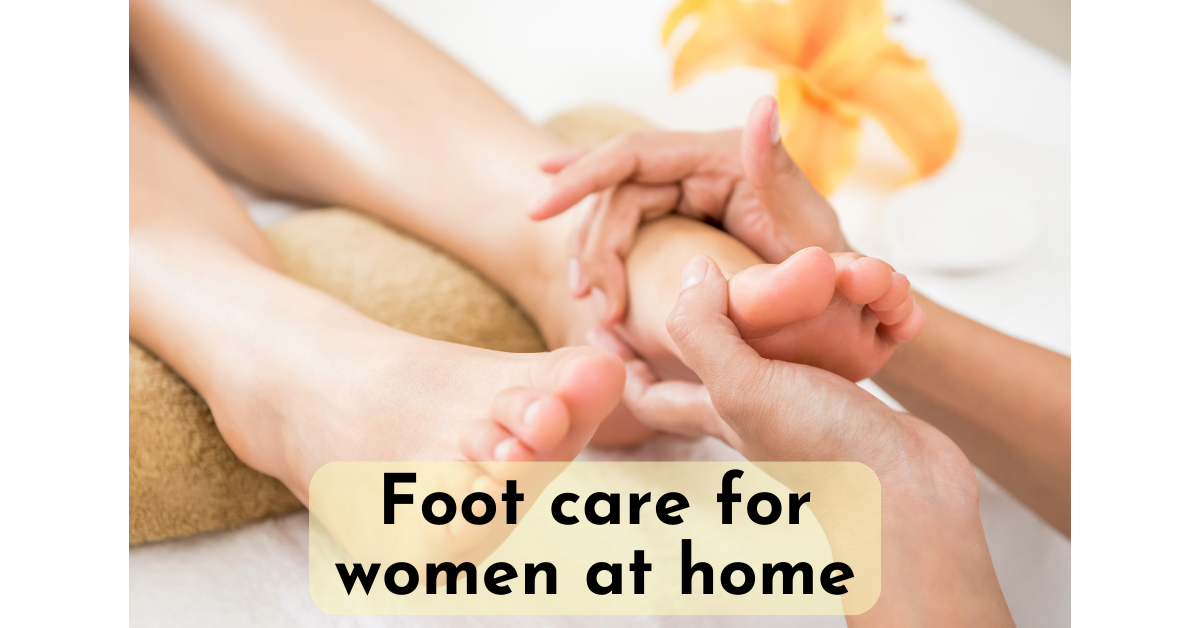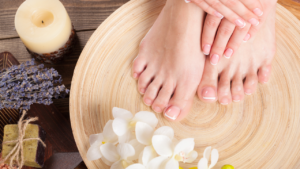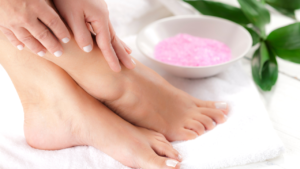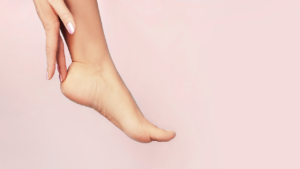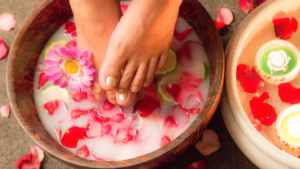Taking care of your feet is essential for overall well-being, and with a few simple steps, you can achieve beautiful and healthy feet right at home. By following a daily foot care routine and incorporating weekly treatments, you can pamper your feet and improve their health.
Key Takeaways:
- Regular foot care at home is crucial for maintaining healthy and beautiful feet.
- A daily foot care routine should include washing, exfoliating, moisturizing, and massaging your feet.
- Indulge in a weekly foot soak to relax and detoxify your feet.
- Proper nail care, including trimming and avoiding cuticle cutting, is important for foot health.
- Address common foot problems at home, but don’t hesitate to seek professional help for persistent issues.
Daily Foot Care Routine for Women
Taking care of your feet is essential for maintaining their health and overall well-being. Establishing a daily foot care routine is an easy and effective way to ensure that your feet stay beautiful and free from common foot problems. Here is a simple guide to help you create a daily foot care routine that you can follow at home.
Step 1: Cleanse and Massage
Start by washing your feet thoroughly with warm water and a gentle soap. Pay special attention to the spaces between your toes and gently scrub your soles with a soft brush. This not only helps in removing dirt and impurities but also provides a relaxing massage to your feet. Massage helps in improving blood circulation and relieving foot fatigue.
Step 2: Exfoliate
Exfoliation is an important step to remove dead skin cells and prevent the buildup of calluses. Use a foot scrub or a pumice stone to gently exfoliate your feet. Focus on areas prone to calluses, such as the heels and balls of your feet. This will leave your feet feeling smooth and soft.
Step 3: Moisturize and Massage
After exfoliating, dry your feet thoroughly and apply a moisturizing lotion. Choose a lotion specifically formulated for feet, as it tends to be thicker and more hydrating. Take this opportunity to give yourself a relaxing foot massage, focusing on the arches and heels. This will further improve blood circulation and help relieve any tension in your feet.
Step 4: Nail Care
Lastly, pay attention to your toenails. Trim them straight across using a nail clipper and use an emery board to smooth any rough edges. Avoid cutting your cuticles as it can lead to infections. Keep your nails clean and well-maintained to prevent ingrown nails and other nail problems.
By following this daily foot care routine, you can keep your feet clean, healthy, and free from common foot problems. Remember to wear comfortable and well-fitting shoes, practice good foot hygiene, and seek medical attention if you notice any persistent foot issues or have underlying health conditions.
Weekly Foot Soak for Relaxation and Detoxification
Give your feet a well-deserved treat with a weekly foot soak that provides relaxation and detoxification. This indulgent self-care practice helps soothe tired feet and promotes overall foot health. With just a few simple ingredients found in your kitchen, you can create a rejuvenating foot soak right at home.
To prepare the foot soak, fill a tub or basin with warm water. Add half a cup of lemon juice, half a cup of vinegar, and a quarter cup of Epsom salt. Mix the ingredients well until the salt is dissolved. The lemon juice helps cleanse and refresh your skin, while the vinegar’s acidic properties aid in removing dead skin cells. Epsom salt, known for its detoxifying properties, helps relieve muscle aches and reduces swelling.
Once your foot soak mixture is ready, immerse your feet in the warm water. Allow them to soak for 10-15 minutes, allowing the ingredients to work their magic. Sit back, relax, and enjoy the soothing sensation as the stress melts away. This is also a perfect time to catch up on your favorite book or listen to some calming music.
After the foot soak, gently pat your feet dry with a towel. Apply your regular moisturizer or a foot cream to lock in the hydration. Take a moment to rub your feet using circular motions, promoting blood circulation and relaxation. This additional step will leave your feet feeling soft, supple, and pampered.
Benefits of a Weekly Foot Soak:
- Relaxes tired muscles and eases tension
- Helps remove dead skin cells and calluses
- Improves blood circulation in the feet
- Reduces foot odor and refreshes the skin
- Aids in the detoxification process
By incorporating a weekly foot soak into your self-care routine, you can give your feet the TLC they deserve. Not only does it provide a moment of relaxation, but it also promotes healthier-looking feet. So go ahead, treat yourself to a luxurious foot soak and indulge in some well-deserved pampering.
| Ingredient | Benefits |
|---|---|
| Lemon Juice | Cleanses and refreshes the skin |
| Vinegar | Removes dead skin cells |
| Epsom Salt | Relieves muscle aches and reduces swelling |
Proper Nail Care for Healthy Feet
Nail care plays a crucial role in maintaining the overall health and appearance of your feet. By following a few simple tips, you can ensure that your nails stay healthy and beautiful. Here are some foot care tips to help you achieve healthy feet and nails at home.
Trimming and Shaping
When trimming your toenails, it’s important to cut them straight across to prevent ingrown nails. Use a nail clipper and avoid cutting them too short, as this can lead to pain and discomfort. After trimming, use an emery board to gently smooth the edges and prevent any sharp corners that may catch on socks or shoes.
Hygiene and Cleanliness
Maintaining proper hygiene and cleanliness is essential for preventing nail infections. Make sure to wash your feet regularly with soap and water, paying special attention to the areas between your toes. Dry your feet thoroughly, as moisture can contribute to fungal growth. If you use nail polish, give your nails a break occasionally to allow them to breathe.
Identifying Nail Issues
Regularly inspect your nails for any signs of discoloration, ridges, or abnormal growth. These may be indications of underlying nail conditions such as fungal infections or nail psoriasis. If you notice any changes in your nails, it’s best to seek advice from a healthcare professional for proper diagnosis and treatment.
| Common Nail Problems | Symptoms | Treatment |
|---|---|---|
| Nail Fungus | Yellow or white discoloration, thickening, crumbling, or brittle nails | Topical antifungal medication, oral antifungal medications, laser treatment |
| Ingrown Nails | Pain, redness, swelling, or infection around the nail edge | Soaking in warm water, gently lifting the nail edge, wearing proper footwear |
| Nail Psoriasis | Pitting, ridges, thickening, discoloration, separation from the nail bed | Topical treatments, phototherapy, systemic medications |
By giving your nails the attention they deserve, you can maintain their health and prevent common nail problems. Remember to practice good nail care habits and seek professional help if you notice any persistent issues. With proper nail care, you can achieve healthy and beautiful feet.
Dealing with Common Foot Problems
When it comes to foot care, it’s important to address common foot problems that may arise. Whether it’s corns, calluses, or athlete’s foot, there are simple self-care techniques that can help alleviate discomfort and promote healing. Here are some tips for dealing with these common foot issues at home:
Treating Corns and Calluses
Corns and calluses are thickened areas of skin that develop in response to pressure or friction. To treat these conditions, start by soaking your feet in warm water for about 10 minutes to soften the skin. Then, use a pumice stone or an emery board to gently file away the thickened skin. Be careful not to file too deeply, as this can cause bleeding or infection. Afterward, apply a moisturizing cream or lotion to keep the skin hydrated and prevent further dryness.
Managing Athlete’s Foot
Athlete’s foot is a fungal infection that commonly affects the feet. To manage this condition, start by keeping your feet clean and dry. Wash your feet thoroughly with soap and water, making sure to dry them completely afterward, especially between the toes. You can also try soaking your feet in warm water with Epsom salt, which can help relieve itching and reduce inflammation. Additionally, use over-the-counter antifungal creams or sprays as directed to treat the infection.
When to Seek Professional Help
While self-care can be effective for common foot problems, it’s important to know when to seek professional help. If you experience persistent foot pain or if your symptoms worsen despite home treatments, it’s advisable to consult with a podiatrist. This is especially true if you have underlying health conditions such as diabetes, as foot problems can lead to serious complications. A podiatrist can provide a proper diagnosis and recommend appropriate treatment options tailored to your specific needs.
| Common Foot Problems | Self-Care Tips |
|---|---|
| Corns and Calluses | – Soak feet in warm water – Gently file thickened skin – Apply moisturizing cream |
| Athlete’s Foot | – Keep feet clean and dry – Soak in warm water with Epsom salt – Use antifungal creams or sprays |
| Persistent Foot Pain | – Seek professional help, especially for underlying health conditions |
By taking proactive measures and addressing common foot problems at home, you can maintain the health and well-being of your feet. Remember to consult a healthcare professional if needed and prioritize self-care to keep your feet feeling comfortable and happy.
Managing Sweaty Feet and Foot Odor
Women often experience the discomfort and embarrassment of sweaty feet and foot odor. Fortunately, there are simple and effective ways to manage this issue at home. By practicing good foot hygiene and exploring various treatment options, you can keep your feet dry, fresh, and odor-free.
Causes of Sweaty Feet
Sweaty feet, scientifically known as plantar hyperhidrosis, occur when your sweat glands produce excessive perspiration. This can be triggered by various factors, such as hot weather, physical activity, stress, or hormonal changes. Additionally, wearing tight shoes or socks made of non-breathable materials can contribute to increased foot perspiration.
Preventing Foot Odor
Preventing foot odor starts with maintaining proper foot hygiene. Wash your feet daily with antibacterial soap and dry them thoroughly, paying special attention to the spaces between your toes. Avoid wearing the same shoes every day to allow them to dry out properly. It’s also beneficial to rotate between different pairs of shoes to give them time to air out. When choosing footwear, opt for breathable materials like leather or canvas that allow air circulation.
“Regularly changing your socks throughout the day can also help minimize foot odor.” – Dr. Sarah Simmons, Podiatrist
- Use foot powders or sprays designed to absorb moisture and neutralize odor.
- Select socks made of moisture-wicking materials like cotton or bamboo.
- Avoid wearing nylon or synthetic socks, as they can trap moisture and contribute to foot odor.
- If your shoes become sweaty or damp, use a shoe deodorizer or sprinkle baking soda inside to absorb moisture and eliminate odors.
Treatment for Sweaty Feet
If basic foot hygiene practices alone don’t alleviate excessive foot perspiration, there are additional treatment options to consider. Antiperspirant sprays or roll-ons specifically formulated for feet can help reduce sweating. Apply them to clean, dry feet before putting on socks and shoes. If over-the-counter solutions prove ineffective, consult a healthcare professional who may recommend prescription-strength antiperspirants or Botox injections to block sweat glands temporarily.
| Treatment Options for Sweaty Feet | Pros | Cons |
|---|---|---|
| Antiperspirant sprays and roll-ons | – Convenient and easily accessible | – May not provide sufficient relief for severe cases |
| Prescription-strength antiperspirants | – More potent and effective | – Requires a healthcare professional’s prescription |
| Botox injections | – Provides long-lasting results | – Involves an invasive procedure |
Remember, it’s essential to consult with a healthcare professional if you experience persistent foot odor or if you have underlying health conditions that may be contributing to excessive sweating, such as hyperthyroidism or diabetes. They can provide personalized guidance and recommend appropriate treatment options to address your specific needs.
Prevention and Treatment of Warts
Warts can be an unsightly and uncomfortable condition that affects the feet. They are caused by a viral infection and can spread easily. However, there are steps you can take to prevent foot warts and effective treatments available if you develop one.
Preventing Foot Warts
To prevent foot warts, it’s important to practice good foot hygiene and take precautions. Avoid walking barefoot in public places such as communal showers, gyms, and swimming pools. Wearing flip-flops or water shoes in these environments can provide a protective barrier against the virus. Additionally, keep your feet clean and dry, as moist environments can facilitate the growth of warts.
Treating Foot Warts
If you develop a wart on your foot, it’s crucial to seek proper treatment to prevent further spread and discomfort. While over-the-counter treatments are available, it’s advisable to consult a healthcare professional for the most effective treatment options. They may recommend topical medications, cryotherapy (freezing the wart), or laser removal for more stubborn warts.
Table: Comparison of Foot Wart Treatments
| Treatment | Advantages | Disadvantages |
|---|---|---|
| Over-the-counter treatments | Accessible and affordable | May take longer to produce results |
| Topical medications | Effective for mild cases | May cause skin irritation |
| Cryotherapy | Quick and effective | May require multiple treatments |
| Laser removal | Precise and targeted | May leave a small scar |
It’s important to note that over-the-counter treatments should be used with caution, and it’s best to consult with a healthcare professional for proper guidance. They can evaluate your specific condition and recommend the most appropriate treatment for your foot warts.
By taking preventive measures and seeking timely treatment, you can effectively manage foot warts and maintain the health and appearance of your feet.
Shoe Inserts and Their Benefits
When it comes to foot care, shoe inserts can provide significant relief and support for various foot conditions. Whether you’re dealing with foot pain, flat arches, or simply looking for added cushioning, the right shoe insert can make a world of difference in your comfort and overall foot health.
The Benefits of Shoe Inserts
Shoe inserts, also known as orthotics, offer several advantages for individuals seeking foot pain relief and enhanced support. Here are the key benefits:
- Improved Arch Support: Inserts designed to provide arch support can help alleviate discomfort caused by flat feet or fallen arches. They distribute pressure evenly and help maintain proper foot alignment.
- Shock Absorption: Shoe inserts with cushioning properties absorb shock when walking or running, reducing the impact on your feet and joints. This can be especially beneficial for individuals with conditions like plantar fasciitis or arthritis.
- Pain Relief: Customized shoe inserts can be tailored to address specific foot conditions or anatomical abnormalities. They can help alleviate pain in areas such as the heels, balls of the feet, or metatarsals.
It’s important to note that while over-the-counter shoe inserts can be effective for many individuals, those with diabetes or poor circulation should consult a healthcare professional for customized orthotics. These inserts are specifically designed to accommodate their unique foot needs and ensure the highest level of comfort and safety.
“I’ve struggled with foot pain for years, but since using shoe inserts, my life has changed. The arch support and cushioning have made a tremendous difference in my day-to-day activities. I highly recommend them for anyone dealing with foot discomfort.” – Sarah R.
| Type of Shoe Insert | Key Features |
|---|---|
| Arch Support Inserts | Designed to provide stability, reduce strain on arches, and alleviate foot fatigue. |
| Cushioned Inserts | Offer extra padding and shock absorption for enhanced comfort and reduced impact on joints. |
| Heel Cups and Pads | Provide targeted cushioning and support for the heel, relieving pain caused by conditions like plantar fasciitis. |
| Metatarsal Supports | Designed to relieve pressure and discomfort in the ball of the foot, commonly associated with conditions like Morton’s neuroma. |
Investing in the right shoe inserts can significantly improve your foot health and overall well-being. Be sure to choose inserts that are appropriate for your specific condition and consult with a healthcare professional if needed. Your feet will thank you for the extra care and support!
Conclusion
Taking care of your feet at home is an important part of women’s self-care. By following a daily foot care routine, indulging in weekly foot soaks, and addressing common foot problems, you can achieve healthy and beautiful feet.
Remember to seek professional medical advice if you have persistent foot issues or underlying health conditions. They can provide guidance and necessary treatment to ensure the well-being of your feet.
With proper care and attention, your feet will feel pampered and confident. So, make foot care for women a priority and enjoy the benefits of a self-care routine that starts from the ground up.
FAQ
Why is taking care of your feet important?
Taking care of your feet is essential for overall well-being. Proper foot care helps to prevent foot problems, maintain healthy skin, and improve comfort and mobility.
What should be included in a daily foot care routine?
A daily foot care routine should include washing your feet thoroughly with warm water and soap, exfoliating dead skin cells, moisturizing your feet, and taking care of your nails.
How often should I soak my feet?
A weekly foot soak is recommended for relaxation and detoxification. Soak your feet in a mixture of warm water, lemon juice, vinegar, and Epsom salt for 10-15 minutes.
How do I properly trim my toenails?
Trim your toenails straight across with a nail clipper and use an emery board to smooth the corners. Avoid cutting your cuticles to prevent infection.
What can I do to address common foot problems like corns and calluses?
Gently reduce corns and calluses using pumice stones or emery boards. Remember to dry your feet thoroughly and apply moisturizer to prevent cracked skin.
How can I manage sweaty feet and foot odor?
Practice good foot hygiene by washing your feet daily with antibacterial soap and drying them thoroughly. Use foot powders or sprays to keep your feet dry throughout the day.
How do I prevent warts on my feet?
Avoid walking barefoot in public places and keep your feet clean and dry. If you develop a wart, see a doctor for proper treatment.
Can shoe inserts help with foot pain?
Yes, shoe inserts can provide additional support and cushioning for common foot problems. Consult a healthcare professional for customized orthotics if needed.
What is the importance of seeking professional medical advice for persistent foot issues?
Persistent foot issues may require specialized treatment or indicate underlying health conditions. It’s important to consult a podiatrist for proper diagnosis and treatment.
You may also be interested in
Effective Solutions for Managing Hair Loss – Your Healthy Scalp Guide
Effective Hair Treatment for Women – Revitalize Your Locks Today!
Unlock the Secret to Healthy Skin with Our Hand Care Guide
Unlock Your Youth: Anti-aging for Women Strategies Revealed
How to Take Care of Your Lips Naturally: Essential Tips
Source Links
- https://www.verywellhealth.com/how-to-have-pretty-feet-1337693
- https://www.webmd.com/skin-problems-and-treatments/healthy-feet-tips
- https://www.feetfirst-footcare.com/blog/874834-podiatrist-recommended-foot-care-routine


